Introduction
In the dynamic realm of web development, the choice of technology stack serves as the foundation upon which applications are built. As developers navigate an ever-evolving landscape filled with diverse programming languages, frameworks, and tools, understanding the intricacies of these stacks becomes essential for crafting high-performing and scalable solutions.
From the time-tested LAMP stack to the modern MERN and Django stacks, each presents unique benefits and challenges that can significantly impact the success of a project. This article delves into the critical components of technology stacks, explores popular options for 2024, and offers key considerations for making informed decisions that align with project requirements and team capabilities.
With the right insights, developers can harness the power of technology stacks to not only meet user expectations but also propel their applications to new heights of efficiency and reliability.
Defining Technology Stacks: An Overview
A software framework is an essential structure that includes the technology stack for web applications, encompassing the range of programming languages, frameworks, libraries, and tools employed by programmers in the development of web solutions. This collection is separated into two main parts:
- front-end (client-side) tools, which shape the user interface and experience,
- back-end (server-side) solutions, which handle data and system logic.
For engineers and project supervisors, a comprehensive grasp of the software framework is essential, as it directly influences the system's performance, scalability, and maintainability.
In the swiftly changing digital environment, selecting the right technology stack for web applications is becoming crucial to their success. Significantly, 9.3% of participants in recent surveys classify as Other Coders, emphasizing the variety of viewpoints in the developer community concerning tools. As Chris Peake, CISO and SVP of Security at Smartsheet, notes,
Additionally, Generative AI has huge potential to strengthen data security and add an extra layer of protection.
Nobody can manually monitor all the data flowing through their business; intelligent systems need to take on that burden. This understanding highlights the importance of incorporating an advanced technology stack for web applications within the framework to improve security and performance. Moreover, the idea of energy networking is gaining more importance, as it improves energy efficiency by optimizing power consumption and emissions tracking, which can be pertinent in the context of system choices.
Moreover, the ongoing popularity of tools such as Jira and Confluence, recognized as the most utilized asynchronous tools by programmers, demonstrates effective software implementations that promote collaboration. Keeping up with the newest trends in the technology stack for web applications for 2024 can equip programmers with the resources they require to build programs that not only satisfy user expectations but also excel in efficiency and reliability.
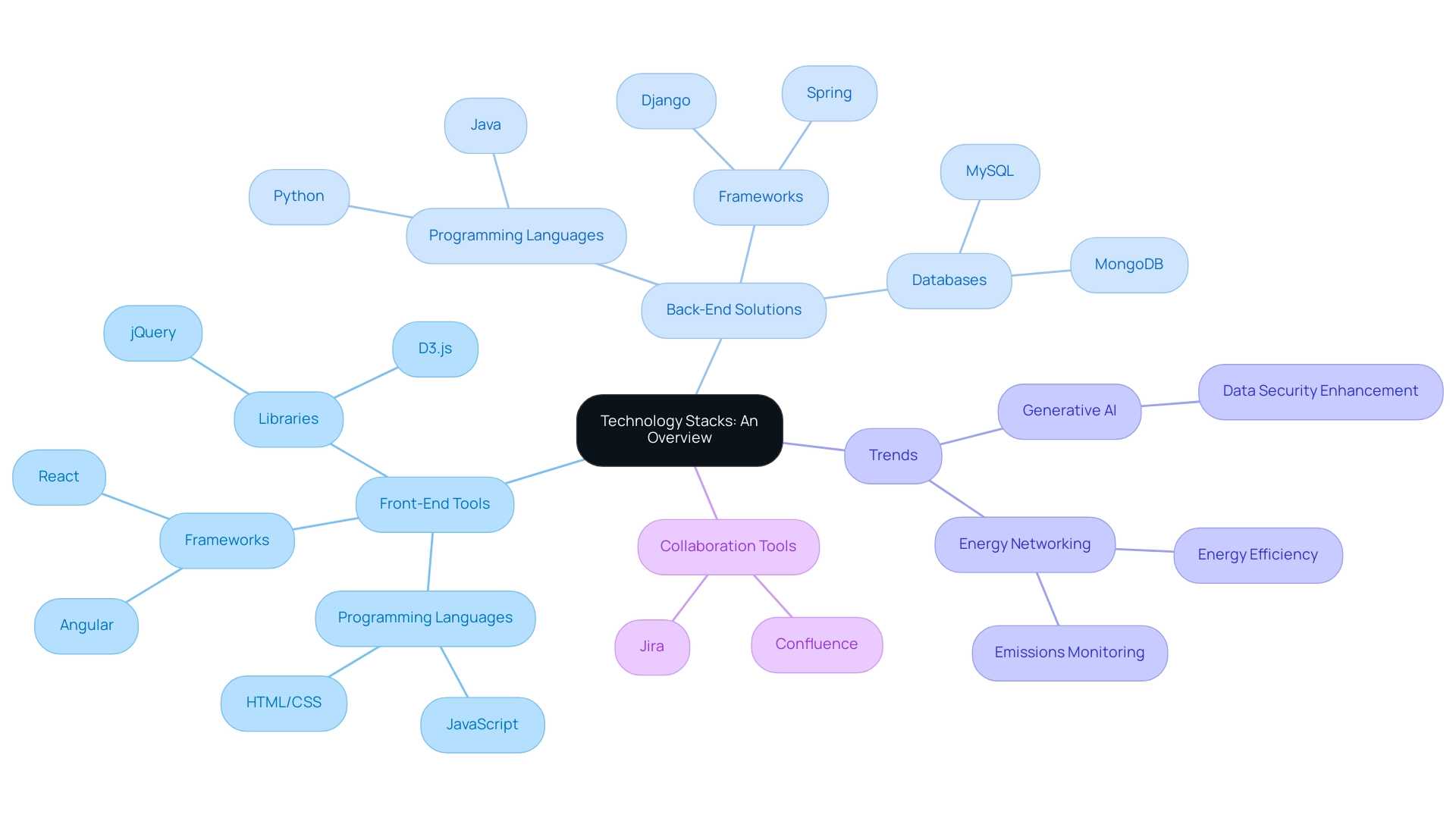
Key Components of a Technology Stack
A robust system stack is essential for developing effective web applications, comprising several crucial components:
-
Front-End Technologies: At the forefront, HTML, CSS, and JavaScript form the backbone of user interface and experience design. Modern frameworks such as React, Angular, and Vue.js enhance this process, enabling developers to create reusable components and optimize rendering efficiency. The continual evolution of front-end technologies is underscored by the insights of industry experts; Luca Mezzalira, a Serverless Specialist Solutions Architect at AWS, notes,
We’ll also see more companies offering micro-frontend solutions integrated with AI. I’ve spoken to a few startups working on exciting new tools that blend front-end development with generative AI.
This indicates a promising trend towards AI-enhanced front-end capabilities, although it’s important to remain cautious; the author expresses skepticism about generative AI's reliability, preferring established tools for code completion. -
Back-End Technologies: The server-side is powered by languages like Node.js, Python, Ruby, and PHP, responsible for executing business logic, managing database interactions, and configuring server environments. Frameworks like Express.js and Django simplify the back-end development process, ensuring efficient software performance.
-
Database Management Systems: Efficient data management is achieved through databases like MySQL, MongoDB, and PostgreSQL. The choice of a database significantly influences a system's performance and scalability, making it a critical decision in the architecture design.
-
Server and Hosting: This aspect encompasses the infrastructure that supports software deployment, including web servers like Apache and Nginx, as well as cloud services such as AWS and Azure, which offer scalable hosting solutions tailored to software needs.
-
APIs and Middleware: APIs play a vital role in enabling communication between different software components, while middleware facilitates data management and enhances interaction between the front-end and back-end systems. This integration is crucial for maintaining the integrity of web platforms, particularly in light of case studies demonstrating the inefficiencies of Headless CMS, where isolated team structures resulted in fragmented projects. Effective communication strategies are essential to mitigate these issues and foster collaborative environments.
Additionally, it's worth noting that the future of Progressive Web Apps (PWA) remains uncertain, with 35.1% of industry respondents believing their popularity will slowly increase, while 32.2% think nothing will change. This statistic reflects the diverse perspectives within the industry, as evidenced by the 13% of respondents falling into the 'Other' category, representing a wide array of fields impacted by web technologies.
These key components collectively define the technology stack for web applications and are instrumental in supporting the latest back-end frameworks and languages that will dominate the landscape in 2024.
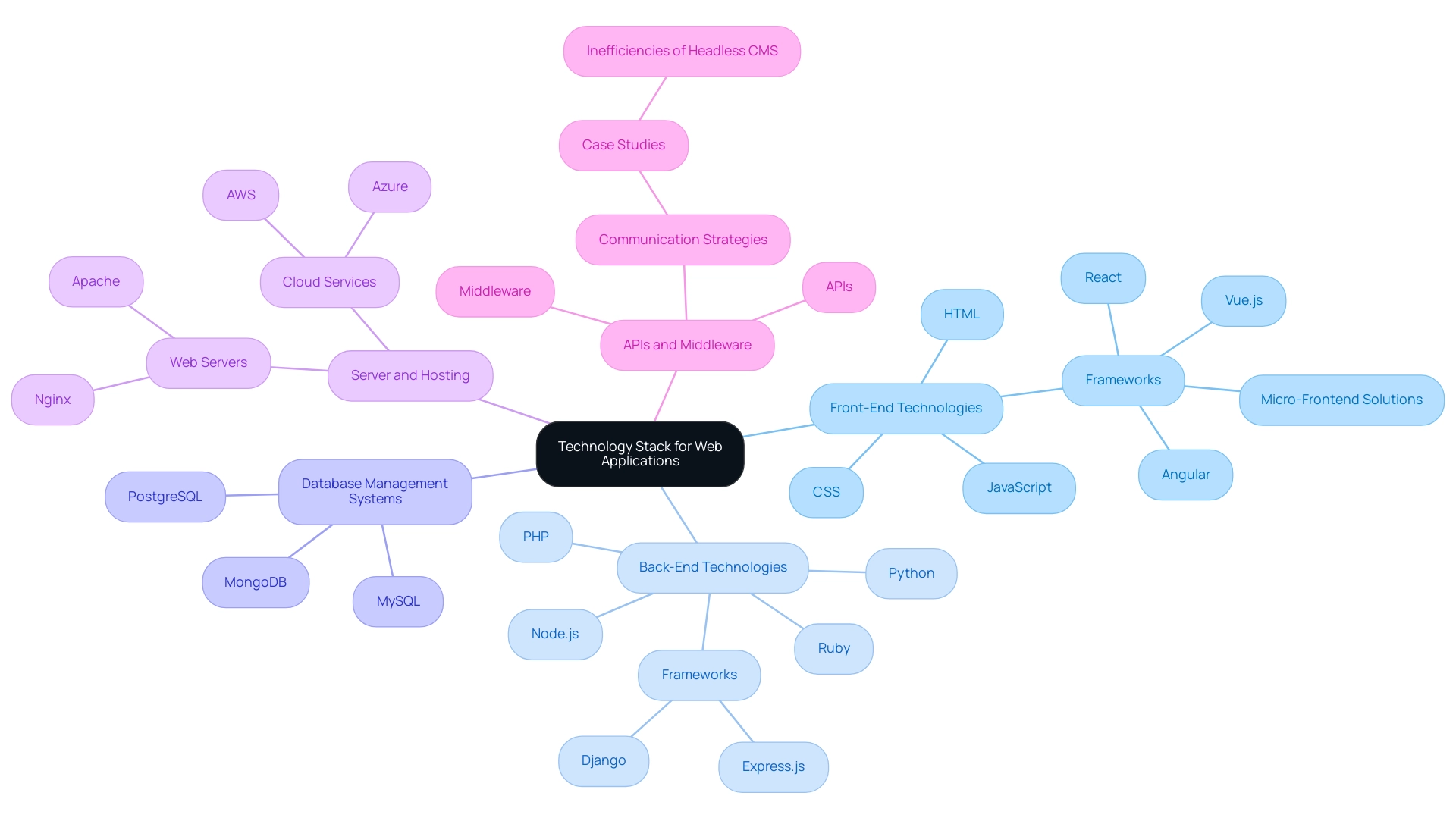
Exploring Popular Technology Stacks for Web Development
In the ever-evolving landscape of web development, several technology frameworks have emerged as leaders, each offering distinct advantages tailored to specific project needs:
-
LAMP: Comprising Linux, Apache, MySQL, and PHP, the LAMP framework has been a cornerstone of web application development due to its robustness and flexibility. MySQL, a stalwart of the relational database world, plays a crucial role in this framework, contributing to its reliability. Its open-source nature ensures a cost-effective solution while facilitating dynamic content management. As Steven Weigold aptly states,
LAMP with Laravel is my go-to, highlighting its continued relevance even in the face of newer technologies. Common questions about the LAMP framework often revolve around its definition, continued usage, and operational mechanics, demonstrating its sustained popularity in web development. -
MEAN Framework: This JavaScript-based framework consists of MongoDB, Express.js, Angular, and Node.js, enabling full-stack development with a single programming language. This homogeneity not only enhances efficiency but also significantly reduces the learning curve for programmers, making it an appealing choice for modern applications.
-
MERN Framework: Similar to the MEAN framework, the MERN framework substitutes Angular for React, which is particularly advantageous for building interactive user interfaces. Its flexibility and performance have made it increasingly popular among creators seeking dynamic front-end solutions.
-
Django Framework: Built on Python, this setup features Django, a high-level web framework, paired with a relational database such as PostgreSQL. Recognized for its simplicity and rapid development capabilities, the Django framework is favored by developers aiming to streamline the creation of complex web applications.
-
Ruby on Rails Framework: Utilizing Ruby as the programming language and Rails as the framework, this setup is celebrated for its convention over configuration philosophy. This approach speeds up development processes, making it a preferred option for startups and projects requiring quick turnaround times.
As we move into 2024, the popularity of these technologies continues to evolve, with the LAMP configuration still maintaining its stronghold due to its proven effectiveness and widespread community support. The strategic selection of a technology stack for web applications should always align with the specific requirements and objectives of a project, balancing the advantages of established tools with the appeal of contemporary innovations. Moreover, comprehending the deployment and infrastructure tools accessible for these systems is crucial for handling software efficiently in production settings.
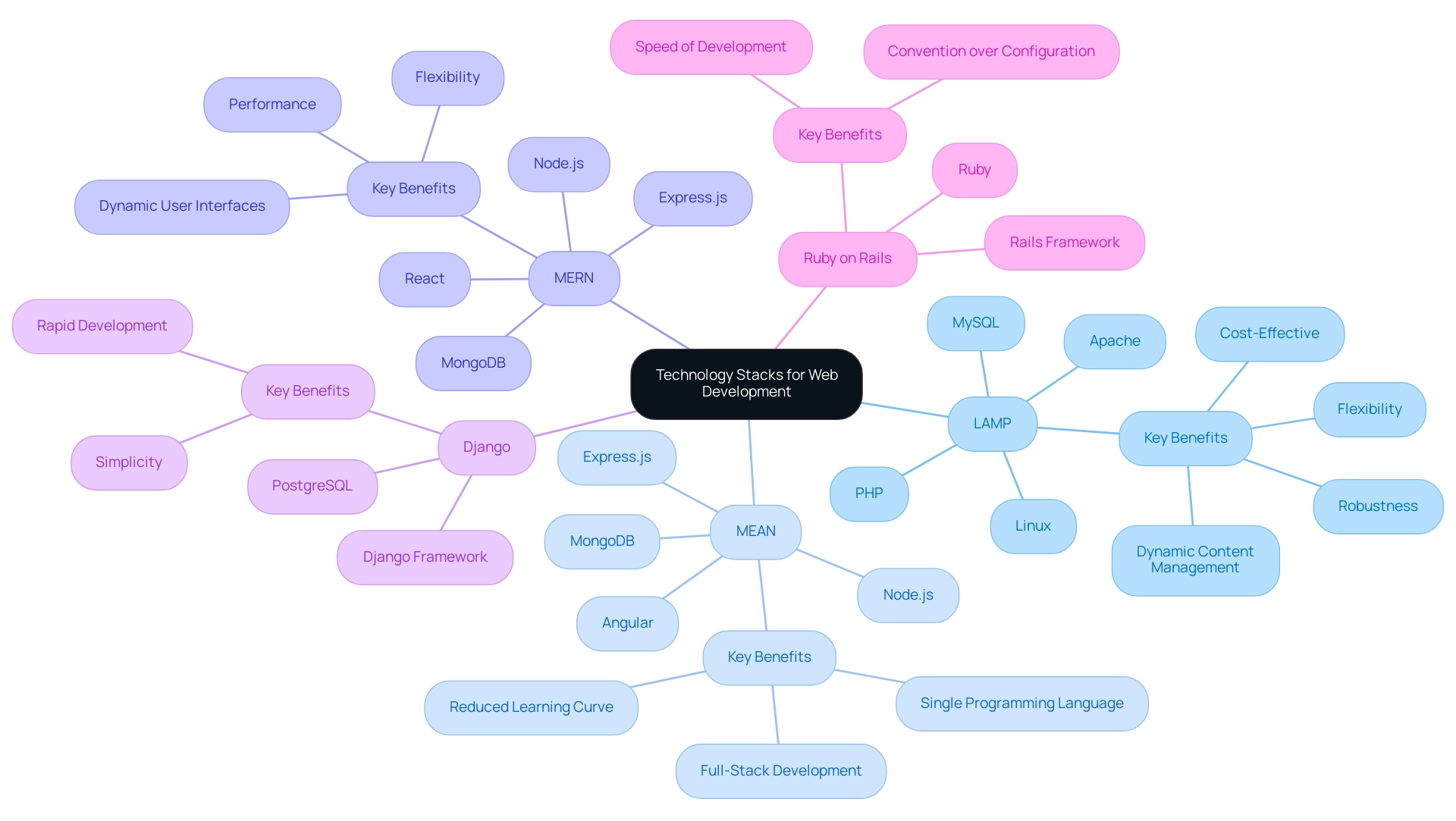
Choosing the Right Technology Stack: Key Considerations
Choosing the appropriate technology framework is essential for the success of any web program, and several key factors must be considered:
- Project Requirements: It is essential to thoroughly understand the specific needs of your application, encompassing functionality, scalability, and performance requirements. A clear definition of these aspects ensures that the chosen technology stack for web applications aligns with both business goals and user expectations.
- Team Expertise: Assessing the skills and experience of your development team is vital. A technology stack for web applications that complements their strengths can lead to more efficient and effective development processes. Recent trends indicate that a substantial segment of programmers express interest in tools like GitHub Copilot, suggesting that utilizing familiar resources can enhance productivity and job satisfaction. In fact, developers spend over 120 minutes a day answering questions, highlighting the importance of selecting tools that minimize troubleshooting time and enhance workflow efficiency.
- Community Support: Choosing solutions with strong community backing and thorough documentation is essential. This accessibility facilitates troubleshooting and provides a wealth of resources, which can be particularly beneficial in the fast-paced technology landscape.
- Scalability: Assess how effectively the system can accommodate growth. A technology stack for web applications that supports horizontal scaling is particularly advantageous, enabling your application to handle increased user loads without sacrificing performance—a necessity in today’s competitive market. For instance, Netflix's technology stack for web applications, which includes languages like JavaScript and frameworks such as React, exemplifies how a well-chosen set of tools can support high performance and scalability in streaming services.
- Cost: Financial implications of the chosen stack should not be overlooked. This encompasses licensing fees, hosting costs, and possible expenses associated with training your team on new systems. In an era where 15.66% of organizations are utilizing AI-assisted tools, understanding the overall investment is imperative for long-term success.
By carefully considering these factors, organizations can make informed decisions that not only meet current project requirements but also anticipate future needs, ensuring sustained growth and innovation.
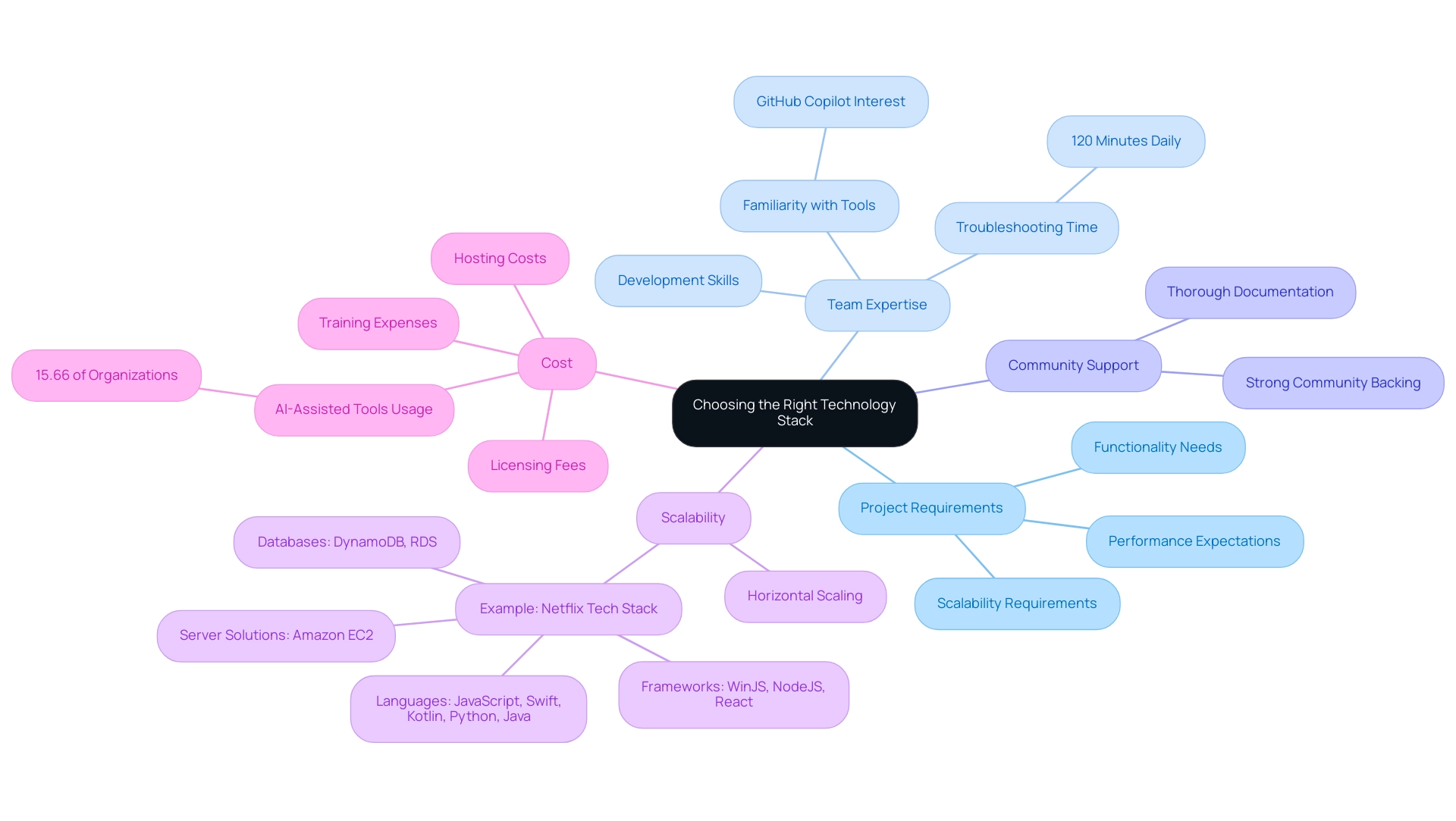
Benefits and Pitfalls of Various Technology Stacks
When choosing a technology framework for web application development, it's essential to consider the unique benefits and challenges each option presents:
-
LAMP Stack: This stack, comprising Linux, Apache, MySQL, and PHP, offers significant advantages, such as a large community and thorough documentation, which can be invaluable for programmers. However, it may face performance issues under high traffic conditions, necessitating careful planning and optimization. A notable case study, titled Personalized Touch, illustrates how LAMP allows developers to extensively customize websites, reflecting individual styles and requirements. This capability significantly enhances user experience and satisfaction. Regular maintenance and updates are crucial for keeping LAMP applications relevant and secure.
-
MEAN Stack: The MEAN stack, consisting of MongoDB, Express, Angular, and Node.js, provides a unified JavaScript development experience. While this can streamline development processes, it may pose challenges for individuals who are less familiar with its various components, particularly Angular and Node.js. A solid understanding of each part is crucial for leveraging its full potential, and without this knowledge, individuals may struggle to implement effective solutions.
-
MERN Stack: Similar to MEAN, the MERN stack (MongoDB, Express, React, Node.js) is acknowledged for its flexibility and efficiency in developing dynamic systems. However, it may present a steeper learning curve for those new to React, which can be a barrier to entry for some developers. Comprehending the intricacies of React and its integration with the other components is essential for successful software development.
-
Django Stack: Known for its rapid development capabilities and clean design, Django can be an excellent choice for projects needing quick turnaround times. Nonetheless, it may not be the best fit for projects that require extensive customization, as its structure can be limiting in such scenarios. Regular updates and maintenance are also crucial to ensure Django projects remain secure and efficient.
-
Ruby on Rails Framework: This framework simplifies web development by adhering to the principle of convention over configuration. While it speeds up the development process, it can lead to performance issues in larger systems, which must be carefully managed. Developers should stay alert regarding sustaining performance as software expands.
Understanding these advantages and drawbacks is crucial for making informed decisions about the technology stack for web applications that align with project objectives. As experts in the field emphasize, 'They regularly maintain and update the technologies so that they remain relevant and secure.' Furthermore, leveraging expert guidance from services like IBM’s Cloud Application Development Consulting can assist organizations in modernizing and accelerating their applications, ultimately cutting maintenance costs by up to 50%.
By applying targeted app modernization strategies, organizations can enhance the effectiveness of their chosen stack.
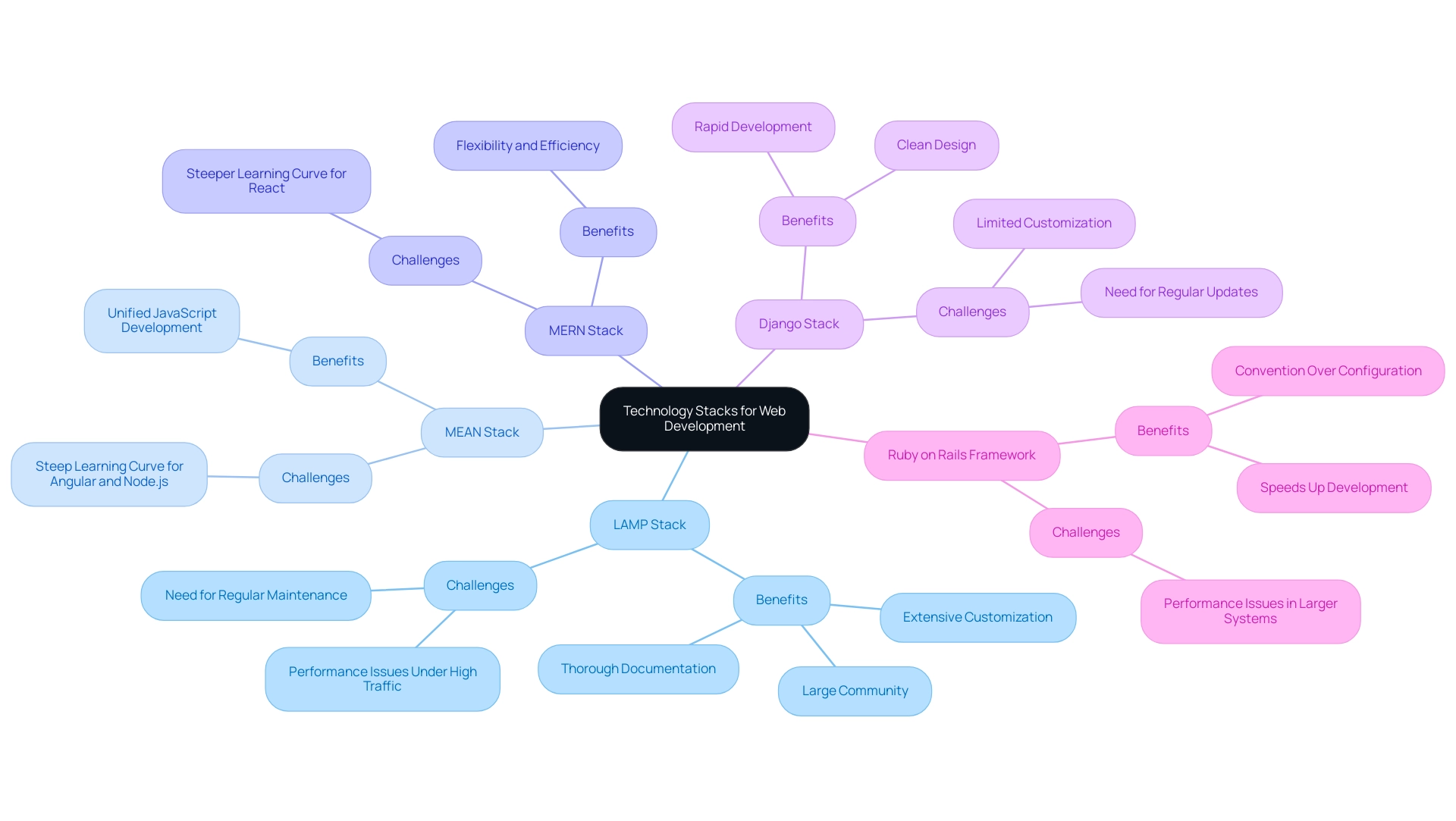
Conclusion
The selection of an appropriate technology stack is a cornerstone of successful web development, influencing everything from application performance to scalability and maintainability. With options ranging from the established LAMP stack to the more contemporary MEAN, MERN, and Django stacks, each choice carries its own set of advantages and challenges. Understanding the key components—front-end and back-end technologies, database management, server and hosting environments, and APIs—enables developers to make informed decisions that align with their project goals.
As the web development landscape continues to evolve in 2024, staying attuned to the latest trends and community insights is crucial. The integration of advanced technologies, such as AI for enhanced security and efficiency, alongside the established frameworks and tools, can significantly elevate the development process. Moreover, considering factors such as team expertise, scalability, community support, and cost will empower organizations to choose a stack that not only meets current needs but also anticipates future growth.
Ultimately, the journey through technology stacks is not merely about selecting tools; it is about laying the groundwork for innovative, high-performing applications that exceed user expectations. By leveraging the right stack, developers can create solutions that not only stand the test of time but also adapt to the ever-changing demands of the digital world. The informed choices made today will shape the success of tomorrow’s web applications, making it imperative to approach technology stack selection with diligence and foresight.





